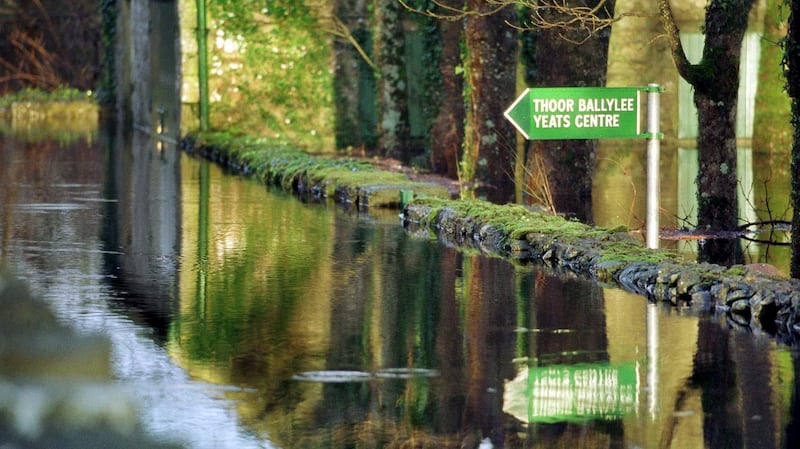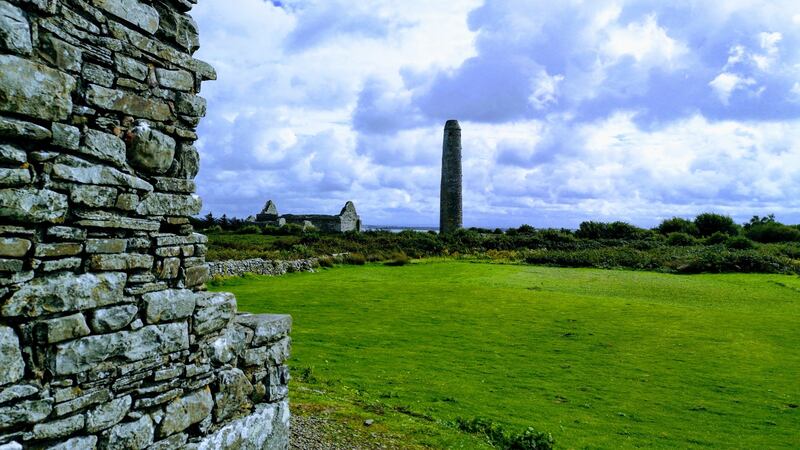Not everything can be saved was one of the stark messages from a recent conference on how to protect our cultural heritage from the impacts of climate change.
The point was raised by Terri Sweeney Meade and Rosemary Bradley from the Office of Public Works (OPW) when they were discussing the ongoing conservation works on Scattery Island in the Shannon estuary.
Entirely in State ownership, Scattery Island is the site of an early Christian settlement and has a round tower, ruins of six churches, cottages and a lighthouse. Bradley and Sweeney Meade are working on a pilot project there which aims to record its so-called intangible heritage for future generations as some of the buildings on the island (including a schoolhouse) have already suffered from flooding and coastal erosion.
The 19th-century pier which is an important access point to the island is itself vulnerable. The Scattery Island Heritage Group is actively recording living memories of life on the island, which was vacated in the 1970s.
“Our work seeks to highlight the climate vulnerability of smaller sites which are an important part of our cultural heritage,” Bradley says.
The OPW has more than 750 heritage sites and 1,000 monuments plus in its care so assessing the climate vulnerability of each site is a mammoth task.
Storm surges, strong waves and intense rainfall contribute to coastal erosion and flooding of heritage sites around the world. We need only think of the Italian city of Venice under flood waters to bring to mind the enormous risks extreme weather events pose to historic buildings and priceless art collections.

In Ireland, Thoor Ballylee, the 15th-century tower house which was once home of William Butler Yeats, suffered serious flooding in recent years. And the OPW managed Dunbeg Fort overlooking Dingle Bay in Co Kerry has lost an estimated 40 per cent of its prehistoric promontory structure.
The OPW flood maps clearly show that a very large number of heritage properties and sites lie within the areas of risk of coastal flooding in high-emission scenarios (30 per cent increase in rainfall and 1,000mm rise in sea level). For example, severe coastal flooding could have adverse impacts on several historic buildings in Trinity College Dublin including the Provost’s House, the Campanile, the Old Library and the Dining Hall.
Dunbeg Fort on the Dingle peninsula is a good example of a much-visited local attraction severely damaged both by long-term coastal erosion, speeded up by extreme weather events in the last five or six years. In 2017, the site was modelled using 3D-imaging software as part of the Irish-Welsh Climate, Heritage and Environments of Reefs, Islands and Headlands (Cherish) research project.
This work aims to set a baseline against which future change can be measured as well as raising awareness of the impact climate change can have on coastal heritage.
Experts at the Climate Change and Cultural Heritage in the Royal Irish Academy (RIA) in Dublin in June reiterated that until recently cultural heritage was left out of climate change discussions by the Intergovernmental Panel on Climate Change and others. And it was only in November 2022 at the United Nations conference of the parties in Egypt, known as Cop27, that the critical links between climate change and tangible cultural heritage was mentioned for the first time – and included in loss and damage and adaptation statements.

Up until the 2021 European cultural heritage Green Paper, Putting Europe’s Shared Heritage at the heart of the European Green Deal, the cultural heritage sector had also been largely excluded in the European context.
“Cultural heritage was left out of the Sustainable Development Goals and the United Nations climate change discussions,” says Jacqui Donnelly, senior architect at the Department of Housing, Local Government and Heritage (DHLGH). Yet, that department’s 2019 Climate Change Sectoral Adapation Plan for Built and Archaeological Heritage – later amalgamated into the Government’s climate action plan – was one of the first in the world.
At the RIA conference, it was widely acknowledged that cultural heritage needs to become climate resilient and that heritage buildings could even play a part in showcasing sustainable solutions.
In Ireland, baseline climate risk surveys of the World Heritage Site at Sceilg Mhichíl (Skellig Michael) have been carried out by the (Cherish) research team from which changes can be measured. Baseline climate risk surveys are due to begin at Bru na Boinne World Heritage Site in 2023. And in Northern Ireland, climate hazard maps have been created for the Giant’s Causeway and the Carrick-a-Rede bridge, both of which are managed by the National Trust. These maps predict that with sea level rise, much of the bay and beaches at the Giant’s Causeway will be underwater by 2100.
Donnelly says that more maps of heritage buildings are needed so that they can be overlaid with flood and coastal erosions risk scenarios to assess vulnerabilities and do risk assessments on specific sites. “We have the National Inventory of Architectural Heritage but we also need a national protected structures map and maps of architectural conservation areas, historic designed landscapes and archaeological landscapes,” she says.
Peter Cox is the managing director of Carrig Conservation, which was commissioned to write Ireland’s Climate Change Adaptation Sectoral Plan for Archaeological and Built Heritage. Carrig Conservation also carried out a climate risk assessment on Ballinskelligs Priory in Co Kerry. Cox suggests that the Government should be setting aside funds to carry out more climate risk assessments on vulnerable coastal and river sites.
“We should be automatically incorporating climate risk assessments in all local area plans, conservation management plans and reviews of cultural heritage buildings and sites on the record of protected structures,” Cox says. In his view, all planning applications for both large and small developments should have a requirement for climate risk assessments.
The Fingal Heritage X Climate citizen science project is a significant scheme which involves local people in monitoring the measuring the impacts of climate change on local heritage.
“Following our climate change risk analysis of 2,200 heritage assets including demesne gardens and archaeological monuments, we came up with a risk register on an interactive map,” explains Christine Baker, heritage officer with Fingal County Council. “And following public heritage workshops, we asked people to monitor sites in their local areas. Some have formed groups who visit sites and take photos which they send to me,” adds Baker, who will map changes and look for funds for any necessary repairs in the future.
Meanwhile, the Environmental Protection Agency with the DHLGH have issued an open call to researchers to fund studies of the impact of climate change on cultural heritage; cultural heritage as a resource for climate mitigation and adaptation and sustainable solutions for cultural heritage.



















